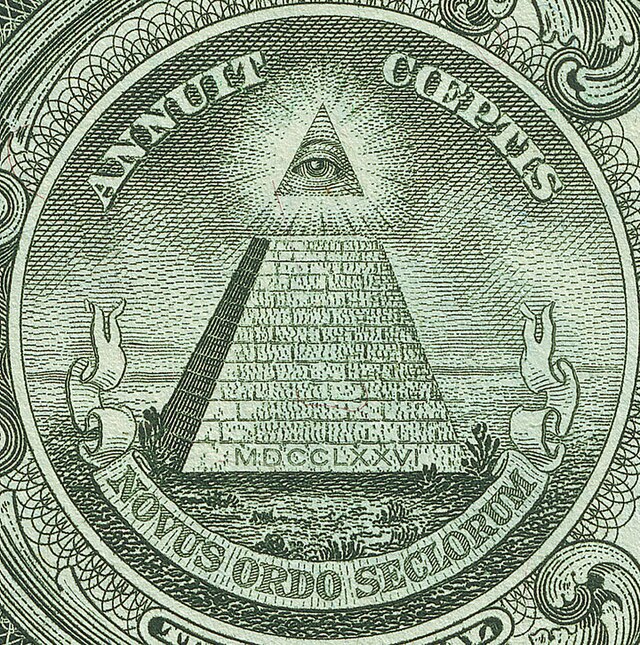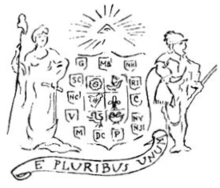Loading AI tools
Symbol From Wikipedia, the free encyclopedia
The Eye of Providence or All-Seeing Eye is a symbol depicting an eye, often enclosed in a triangle and surrounded by rays of light or a halo, intended to represent Providence, as the eye watches over the workers of mankind.[1][2][3] A well-known example of the Eye of Providence appears on the reverse of the Great Seal of the United States, which is depicted on the United States one-dollar bill.


In 1782, the Eye of Providence was adopted as part of the symbolism featured on the reverse side of the Great Seal of the United States. It was first proposed as an element of the Great Seal by the first of three design committees in 1776, and it is thought to be the suggestion of the artistic consultant Pierre Eugene du Simitiere.[4] At the time, it was a conventional symbol for God’s benevolent oversight.[5]
In his original proposal to the committee, du Simitiere placed the Eye over shields so as to symbolize each of the original thirteen states of the Union. On the version of the seal that would eventually be approved, the Eye is positioned above an unfinished pyramid of thirteen steps (again symbolizing the original States, but also incorporating the nation's potential for future growth). Such symbolism is explained through the motto that appears above the Eye, annuit cœptis, meaning "He approves [our] undertakings" (or "has approved").[6][7]
Perhaps due to its use in the design of the Great Seal, the Eye has made its way into other American seals and logos, such as, for example:
The Eye of Providence has been used among various forms of currency throughout U.S. history, including:
The Eye of Providence appears on several Lithuanian coats of arms, including those of:


The Eye of Providence appears on the coats of arms of Victoria, Canada; Brasłaŭ, Belarus; Neman, Russia; and Radzymin and Wilamowice, Poland. The Eye was also part of the flag and coat of arms adopted by the Confederation of the Equator, a short-lived 1824 secessionist revolt in the northeastern provinces of Brazil. In the United Kingdom, the symbol was part of the Guards Division insignia, created in 1915.
In Estonia, the 50 krooni note shows the Eye as part of a depiction of the pipe organ of the Käina church. Likewise, the (old) 500 Ukrainian hryvnia note also depicts the Eye.
The Eye was included in the original publication of France's Declaration of the Rights of Man and of the Citizen,[5] which also borrows iconography from the Ten Commandments. Similarly, the symbol is featured on the front page of the Constitution of Serbia from 1835. In Nigeria, the eye symbol is part of the Nigeria Customs Service logo.

Today, the Eye of Providence is often associated with Freemasonry, first appearing as part of the standard Freemason iconography in 1797 with the publication of Thomas Smith Webb's The Freemason's Monitor.[11][12]
In this use, the Eye, representing the all-seeing eye of God, serves as a reminder that humanity's thoughts and deeds are always observed by God—who is referred to in Masonry as the Great Architect of the Universe. Typically, the Masonic Eye of Providence has a semicircular glory below it, and is sometimes enclosed by a triangle.
Popular among conspiracy theorists is the claim that the Eye of Providence shown atop an unfinished pyramid on the Great Seal of the United States indicates the influence of Freemasonry in the founding of the United States. However, common Masonic use of the Eye dates to 14 years after the creation of the Great Seal. Furthermore, the only Mason among the members of the various design committees for the Great Seal was Benjamin Franklin, whose ideas for the seal were not adopted. Likewise, various Masonic organizations have explicitly denied any connection to the creation of the Seal.[13][14]

The association of an eye with the concept of Divine Providence is found in Christianity. In late Renaissance European iconography, the Eye, surrounded by a triangle, was an explicit symbol of the Christian Holy Trinity.[15] The Eye of Providence was later painted above an image of three faces in Pontormo's 1525 Supper at Emmaus.[5] Seventeenth-century depictions of the Eye sometimes show it surrounded by clouds or sunbursts.[16] The Eye of God in a triangle is still used in church architecture and Christian art to symbolize the Trinity and God's omnipresence and divine providence.
The Eye of Providence is notably featured on the following buildings of the Roman Catholic Church, Eastern Orthodoxy, and The Church of Jesus Christ of Latter-day Saints:
Several universities and college fraternities use the Eye of Providence in their coats of arms, seals, or badges, notably:
Seamless Wikipedia browsing. On steroids.
Every time you click a link to Wikipedia, Wiktionary or Wikiquote in your browser's search results, it will show the modern Wikiwand interface.
Wikiwand extension is a five stars, simple, with minimum permission required to keep your browsing private, safe and transparent.